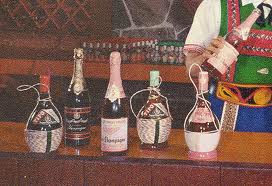Shortly after my last post, in which I lamented the lack of American wines made from Italian grape varietals, my mother emailed me this YouTube clip of a vintage Italian Swiss Colony wine commercial. If you watch it, and account for the fact that it's 50 years old, I think you'll have to agree that it's just as good as any of the commercials that were shown during the game. According to sources, Italian Swiss Colony was once the world's largest and most productive winery, as well as California's second largest tourist attraction after Disneyland.
The winery was founded in 1881, by Genoan native, Andrea Sbarboro, who had emigrated to California in 1850. Sbarboro's original vision revolved around establishing a cooperative vineyard as a means of providing gainful employment for his fellow Italian (and few Swiss) immigrants, but declines in grape prices dictated that the economic model of Sbarboro's plan had to include wine production to be profitable. At its peak, the winery reportedly held over 5,000 acres of vineyards, and it's production in 1910 was 14,250,000 gallons. Varietals planted in the estate's holdings included Zinfandel, Carignane, Mataro (Mourvedre/Monastrell), Barbera, Cabernet Sauvignon, Pinot Noir, Riesling, Pinot Blanc, Muscat, and Sauvignon Blanc. Interestingly enough, despite the fact that Italian Swiss Colony was founded and developed by Italian immigrants, the only traditionally Italian grapes in its holdings are Barbera and Muscat.(see references below)
 The "Little Old Winemaker"Like most early California wineries, Italian Swiss Colony's success was interrupted by prohibition, but the company rebounded to the point that its commercials, like the one above were culturally relevant for children of the 1960s, like my mother. Grape grower Louis Petri is credited with rebuilding the brand in the aftermath of prohibition, implementing a post WWII production strategy of shipping wine by tanker to New York to be bottled and sold. Petri also created the character of the "little old winemaker," who would become synonymous with the brand to the point that my mother can still quote his lines from the Italian Swiss Colony commercials, nearly 50 years later.
The "Little Old Winemaker"Like most early California wineries, Italian Swiss Colony's success was interrupted by prohibition, but the company rebounded to the point that its commercials, like the one above were culturally relevant for children of the 1960s, like my mother. Grape grower Louis Petri is credited with rebuilding the brand in the aftermath of prohibition, implementing a post WWII production strategy of shipping wine by tanker to New York to be bottled and sold. Petri also created the character of the "little old winemaker," who would become synonymous with the brand to the point that my mother can still quote his lines from the Italian Swiss Colony commercials, nearly 50 years later.
Italian Swiss Colony encountered financial difficulties following its decades of success in the 1950s and 1960s, and in 1969, it was sold to Heublein Wines in the first of many transactions that saw Italian Swiss Colony pass from corporation to corporation, with a brief period in which it was owned by Allied Growers. Today, it is known as Cellar No. 8.
 While Italian Swiss Colony's wine production appears to have been largely concentrated in the bulk/jug/industrial wine market, with its best-selling wine "Tipo" being housed in faux-Chianti packaging, I find it encouraging to see that the winery was selling rosé back in the 1950s and 1960s. It also adds another bit of mystery to the question of why there are so few American wines made from traditionally Italian varietals, given the fact that the winery was founded and grown to prominence by Italian immigrants. The Italians were extremely influential in the founding and development of the American wine industry. It is extremely perplexing that Italian grape varietals do not occupy a place of greater stature in our country's wine production.
While Italian Swiss Colony's wine production appears to have been largely concentrated in the bulk/jug/industrial wine market, with its best-selling wine "Tipo" being housed in faux-Chianti packaging, I find it encouraging to see that the winery was selling rosé back in the 1950s and 1960s. It also adds another bit of mystery to the question of why there are so few American wines made from traditionally Italian varietals, given the fact that the winery was founded and grown to prominence by Italian immigrants. The Italians were extremely influential in the founding and development of the American wine industry. It is extremely perplexing that Italian grape varietals do not occupy a place of greater stature in our country's wine production.
As a reminder, TruthInJuice.com will be examining the lack of American wines made from traditionally Italian varietals over the next few weeks, culminating in a comparative tasting between American wines made from traditionally Italian varietals, and their native Italian counterparts. If you have any suggestions for wines that should be included in this tasting, please feel free to note them in the comments section, or submit a general question form.